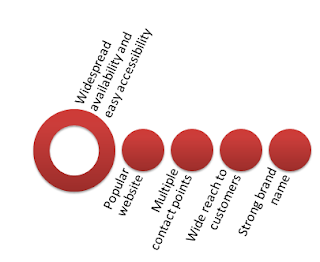Developing a business model requires four key choices on the part of the senior management:
- Value Clustering/Business Idea Generation: The target group to be addressed need to be decided and the value proposition need to be defined.
- Marketplace Offering: Studying the competitive landscape in the existing target group space
- Resource Systems: Alignment of resources to optimize results
- Financial Model: Deciding how can the business idea be self-sustaining, and if not, how can it clear funding requirements
Egg model framework is used to map the value offering to the decision process
- Need Recognition: What occasions trigger the need for my product? What tactics can simulate demand?
- Search for ideas and offerings: What information would the consumer need to make the selection?
- Evaluation of alternatives: What key evaluation criteria will the consumer use? What information will price, picture, product description delivery information and availability convey?
- Purchase Decision: What do the peers of the consumer think of the product? Are there any unforeseen circumstances that the consumer feels as impediments to the purchase process?
- Post-sale Support and Perks: How can the purchase dissonance be minimized by assuring that the other products do not satisfy what my products provide? How can consumer re-purchase be assured?
Understanding this with the example of e-Bay, which has a three-fold strategy: to do quality acquisition, to enhance experience, and to build relevance. eBay is achieving quality acquisition through internet marketing (SEM and SEO), forging strategic partnerships (Citibank). It is enhancing its consumer experience through online marketing, direct mailers and coupons and merchandising. Besides, it is building relevance through social media and IPL engagements.
While the proposition of eBay is to provide a fun marketplace that connects with people who love it for the abundant varieties and great deals that it offers. It's target group is primarily the young user aged between 18-45 years and uses the internet. They are largely male. The benefits it offers include emotional and rational. Emotional benefits include having fun, success, thrill of winning. Rational benefits include lucrative deals, plethora of choices and safety. eBay's personality is fun-loving, and vibrant, innovative and confident. Its voice is confident, optimistic, honest and fun.
But if it were to be studied systematically, there are four steps towards building a robust and sustaining e-business model:
Identification of Core Benefits: In eBay's case, the following four core benefits can be determined:
Link capabilities to benefits: For each of the core benefit identified, a capability needs to be linked up. In our specific example, "Widespread and Easy Accessibility" can be linked to capabilities like popular website, multiple contact points, wide reach to customers and strong brand name.
Develop Activities and Assets: To each of the capabilities identified, we need to develop activities and assets. In the above case, the capability "Multiple contact points" can be achieved by developing activities and assets like Affiliates, Telephone and Online presence.\
Ability to deliver capabilities: For each of the assets and activities identified, they need to be enriched with proper abilities to reach those.
Therefore, with these sets of planned activities, designed to result in a profit in the marketplace, it forms the heart of a business plan.
- Akshay Kumar (12DM-020) EBUS, Section A




No comments:
Post a Comment
Note: only a member of this blog may post a comment.